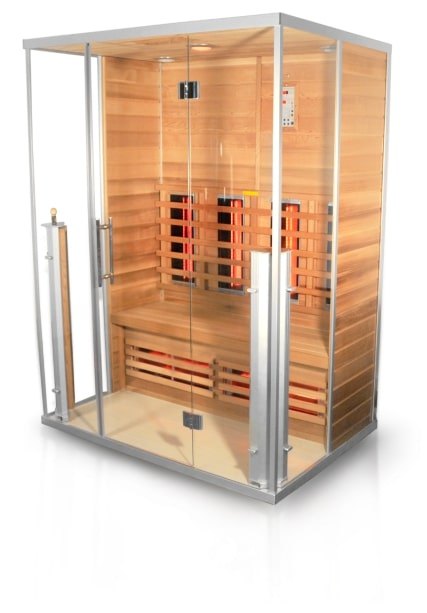What are the benefits of infrared saunas?
Infrared saunas use infrared lamps and electromagnetic waves instead of traditional hot coals to create a warm, blissful sauna experience. But, what are the reasons behind this and why are infrared saunas so beneficial?
Let us delve into the world of saunas to explain…

What are infrared saunas?
Unlike a traditional sauna, infrared saunas don’t heat the air around you. Instead, they use infrared light (that uses electromagnetic waves), which penetrates the skin and warms your body directly.
An infrared sauna can operate at a lower temperature (usually between 45˚C and 60˚C) than a traditional sauna, which is typically between 65˚C and 90˚C. This climate is more tolerable, which allows you to stay in the sauna longer while increasing your core body temperature by two to three degrees.
Infrared sauna health benefits
-
Improved heart and lung health
Your heart rate is significantly raised when in a sauna, compared to at rest, due to the infrared heat. So, when in the sauna for a prolonged time, such as 30 minutes, this can almost be compared to a light, steady cardiovascular workout.
-
Weight loss
This workout that your body is doing, in the infrared sauna, also burns calories. It has been proven in a study that participants using an infrared sauna, 3 times per week for 30 minutes, dropped an average of 4% body fat over 4 months of use [1].
-
Soothes sore muscles
The improvement in your blood circulation from being in an infrared sauna can help accelerate muscle recovery [2]. Warm muscles also relax and stretch more, which can provide a better range of movement and aid with rehabilitation.
-
Pain relief
Infrared saunas can reduce inflammation and pain due to the increased blood flow achieved from the deeper penetration of your tissue than you get from a regular sauna or hot bath. Studies [3] have repeatedly shown that a short course (4 weeks) of infrared saunas has significantly reduced pain, stiffness and chronic fatigue.
-
Relaxation
It is widely known that heat exposure elevates serotonin levels, which are your mood regulators. Studies [4] have even shown that a single sauna treatment can improve the symptoms of major depression for as long as six weeks.
-
Better sleep
We all know how difficult it is to have a good night’s sleep on a hot summer’s night as maintaining a cool body temperature is essential for falling asleep. By warming your body in an infrared sauna and then letting it cool down after, it leaves you with a cool body ready for sleep and a calm mind.
-
Increased resistance to illness
The infrared sauna increases your core temperature, which tricks your immune system into thinking that you have hyperthermia [5]. Hyperthermia does not just relate to exposure to extreme cold but, by definition, is just when the body’s heat regulation system doesn't work properly causing you to become hot. As an effect of this, your immune system releases its virus-fighting army resulting in increased resistance to illness.
-
Flush out toxins
Infrared saunas are an excellent way to detox your body. They cause you to sweat out the toxins accumulated in everyday life contaminants such as pesticides, metals and PCBs from plastics or environmental pollution while also improving skin health by promoting collagen production [6].
Top tips for using infrared saunas
- #1 Maximum time - Keep sessions to 30 minutes, 3-4 times per week to limit the stress on your body.
- #2 Stay hydrated - As you are sweating it out, your body can be left dehydrated so make sure you have water with you for every session.
- #3 Dry off afterwards - The toxins that you have sweated out will be reabsorbed by your skin if you do not dry off after your session.

Infrared Sauna in Brisbane Northside
If you have any further questions or would like to discuss Infrared Saunas, please call us on 07 3857 8887
[1] Kenneth McLeod
[2] A. Mero et al. (2015)
[3] F. G. J. Oosterveld et al. (2009), Soejima et al. (2015) , Amano et al. (2014) & Matsumoto et al. (2011)
[4] C. W. Janssen et al. (2016)
[5] R. P. Patrick & T. L. Johnson (2021)
[6] J. H. Lee et al. (2006)
Search Help Section by Service
Search our information section by a specific service. Simply click the tile below.








